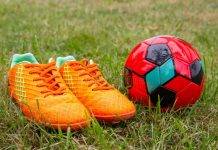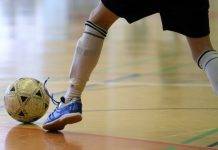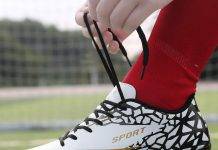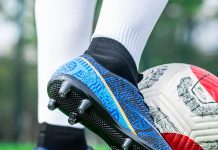Ah, the age-old question for soccer enthusiasts: do I need turf soccer cleats? We’ve all pondered this dilemma at some point in our athletic journey, whether on the field or in the stands.
The answer, as always, lies in the specifics of your game and your playing surface. This article will examine the advantages of turf soccer cleats and help you determine if they’re worth investing in your soccer prowess. So lace up your boots, folks, and let’s navigate the playing field together!
What are turf soccer cleats?
Turf soccer cleats are specific footwear designed for playing soccer on artificial turf surfaces. Unlike traditional soccer cleats, designed for natural grass fields, turf soccer cleats have unique features that provide optimum performance and safety on artificial surfaces. These cleats have shorter, evenly distributed, and more numerous rubber or synthetic studs on the outsole, providing enhanced turf traction and stability.
Definition of turf soccer cleats
Turf soccer cleats are soccer shoes manufactured explicitly for playing on artificial turf surfaces. They feature a distinct soleplate with numerous short studs made of rubber or synthetic material designed to provide maximum grip and prevent slipping on the turf. The upper part of the cleats typically includes materials like leather, synthetic leather, or synthetic materials to provide durability and comfort.
Features of turf soccer cleats
Turf soccer cleats have several notable features that distinguish them from other types of soccer footwear. The most prominent feature is the outsole, with multiple, shorter studs evenly distributed across the sole. These studs are designed to provide maximum traction on artificial turf, allowing players to maintain grip and control while making quick turns and sudden movements on the surface. Additionally, turf soccer cleats often have a more flexible soleplate to accommodate the demands of playing on turf.
Different types of soccer cleats
Understanding turf soccer cleats is necessary within the context of other soccer cleats. Here’s a brief overview of the different types available:
Review contents
Firm-ground (FG) soccer cleats
Firm-ground soccer cleats are designed for playing on natural grass fields. They typically feature longer, bladed, or conical studs penetrating the ground, providing stability and traction on wet or muddy surfaces. However, firm-ground cleats may not perform optimally on artificial turf and can potentially damage the turf due to their longer studs.
Soft-ground (SG) soccer cleats
Soft-ground soccer cleats are designed to play on soft, muddy, or wet natural grass fields. These cleats usually have longer, detachable studs that can be interchanged depending on the field conditions. Soft-ground cleats offer superior traction and prevent players from sinking into the ground, providing stability and control while running and maneuvering on slippery surfaces.
Turf soccer cleats
As discussed earlier, turf soccer cleats are designed for playing on artificial turf surfaces. They have shorter, evenly distributed rubber or synthetic studs that provide excellent grip and prevent slipping on the turf. These cleats are specifically engineered to enhance performance and protect players from the unique demands of turf fields.
Indoor soccer shoes
Indoor soccer shoes are designed for playing on indoor court surfaces like gyms or sports halls. They usually have a non-marking rubber outsole that provides grip and traction on hard, smooth surfaces. Indoor soccer shoes are lightweight flexible, and feature a low-profile design to enhance movement and ball control in a confined indoor setting.
When to wear turf soccer cleats
Knowing when to wear turf soccer cleats is essential for maximizing performance and safety on the field. Here are the situations where turf soccer cleats are most suitable:
Playing on artificial turf
Turf soccer cleats are specifically designed for playing on artificial turf surfaces. The rubber or synthetic studs on the outsole provide the necessary grip and traction to navigate the unique texture and hardness of the turf. Wearing turf cleats on artificial turf ensures optimal performance stability and helps prevent slips and falls during the game.
Playing on hard, dry natural grass
While not their primary purpose, turf soccer cleats can be used on complex, dry, natural grass fields. The shorter studs of turf cleats provide better stability and prevent excessive slipping on hard surfaces. However, it is essential to note that firm-ground cleats would be more suitable for longer or wet grass as they offer deeper penetration and overall traction.
Playing on hard court surfaces
Players may sometimes find themselves playing soccer on hard court surfaces such as concrete or asphalt. Turf soccer cleats can be suitable for playing on these hard surfaces. The rubber studs grip the more complex ground and provide improved traction, enabling players to maneuver and change direction without slipping.
Advantages of wearing turf soccer cleats
Choosing the proper footwear for soccer is crucial, and wearing turf soccer cleats offers several advantages that contribute to improved performance and safety on the field. Some of the critical advantages of wearing turf soccer cleats include:
Improved traction
The numerous rubber or synthetic studs on the turf soccer cleats’ outsole provide exceptional traction on artificial turf surfaces. The distribution and design of these studs allow players to make quick turns, perform agile movements, and maintain grip without slipping. This enhanced traction allows players to move confidently, accelerating and decelerating with control.
Enhanced stability
The design of turf soccer cleats offers enhanced stability on turf surfaces. The shorter studs provide a solid base and prevent excessive ankle rolling or twisting, reducing the risk of sprains and injuries. The improved stability also helps players maintain balance during tackles, sprints, and quick changes in direction, enabling them to perform at their best.
Reduced risk of injury
Turf soccer cleats are designed to optimize safety while playing on artificial turf. The shorter studs reduce the risk of cleats getting caught in the turf, minimizing the chance of twisting or spraining ankles. Additionally, turf cleats’ improved grip and stability result in better control over foot movements, reducing the likelihood of slips, falls, or collisions with other players.
Better ball control
Turf soccer cleats allow for better ball control on artificial turf. The shorter studs provide a closer connection to the ground, giving players improved sensitivity and feel when dribbling, passing, or shooting. The enhanced grip and stability also contribute to precise movements and adjustments, helping players maintain control of the ball even in challenging situations.
Disadvantages of wearing turf soccer cleats
While turf soccer cleats have numerous advantages, there are some potential drawbacks to consider before purchasing them. It is essential to weigh the disadvantages against your specific playing conditions and requirements. Here are a few disadvantages of wearing turf soccer cleats:
Limited use on other surfaces
Turf soccer cleats are specifically designed for artificial turf surfaces. While they can be used on hard, dry natural grass or hard court surfaces to some extent, their design and stud configuration may not provide optimal performance on these surfaces. Firm-ground or soft-ground cleats are typically more suitable for optimal performance on natural grass, depending on the field conditions.
Not suitable for wet conditions
Turf soccer cleats are not best for playing on wet natural grass fields. The shorter studs on these cleats do not provide sufficient traction and penetration on slippery or muddy surfaces. In wet conditions, longer studs on firm-ground cleats or soft-ground cleats are generally recommended to ensure better stability and grip.
Less durability
Due to the demands of playing on artificial turf, turf soccer cleats may have a shorter lifespan than other soccer cleats. The rubber or synthetic studs on the outsole can wear down more quickly on abrasive turf surfaces, reducing traction over time. Maintaining and caring for your turf cleats properly is essential to extend their durability.
Considerations before buying turf soccer cleats
Before purchasing turf soccer cleats, several important factors should be considered to ensure the best fit and performance on the field. These considerations include:
Playing surface
Assess the primary playing surface where you will use the cleats. If you predominantly play on artificial turf, then turf soccer cleats are suitable. However, if you frequently play on natural grass or other surfaces, such as indoor courts, you may want to consider owning multiple pairs of cleats or opting for a more versatile option.
Weather conditions
Consider the typical weather conditions you will encounter during your games. While turf soccer cleats perform well on dry artificial turf, they are less suitable for wet grass or extreme weather conditions. If you often play in wet conditions, consider purchasing an additional pair of cleats designed for such circumstances.
Frequency of use
Assess how frequently and intensively you play soccer. Investing in a high-quality pair of turf soccer cleats with durable materials would be worthwhile if you are a competitive player who participates in regular games and practices. However, a more budget-friendly option may be suitable if you only engage in occasional recreational games.
Budget
Consider your budget when purchasing turf soccer cleats. Prices can vary depending on the brand, materials, and added features. It is essential to balance affordability and quality, ensuring the cleats meet your needs without breaking the bank.
How to choose the right turf soccer cleats
Choosing the right turf soccer cleats involves considering various factors to ensure an optimal fit and performance. Here are some key considerations when selecting turf soccer cleats:
Size and fit
Proper sizing is crucial for comfort and performance. Ensure that the cleats fit snugly but comfortably. Avoid choosing too tight or loose cleats, as they can result in discomfort or injury. Try on different brands and models to find the one that best suits your foot shape and size.
Turf sole plate
Inspect the soleplate of the cleats. Look for a flexibly designed soleplate that can adapt to the demands of turf surfaces. The studs should be short and dense, providing excellent traction without excessive penetration into the turf. Additionally, consider options with multidirectional stud patterns to enhance maneuverability.
Materials and construction
Evaluate the materials used in the construction of the cleats. The upper part of the cleats can be made of leather, synthetic leather, or synthetic materials. Leather offers durability and flexibility, while synthetic materials often provide lighter weight and water-resistant properties. Choose materials that suit your preferences and playing conditions.
Added features
Consider any additional features offered by the cleats. Some models may have enhanced cushioning, ankle support, or breathability. Assess your needs and preferences to determine which features are essential for your playing style and comfort.
Maintaining turf soccer cleats
Proper maintenance of turf soccer cleats is essential to ensure longevity and optimal performance. Here are some tips for maintaining your turf soccer cleats:
Cleaning after use
After each use, remove any dirt, mud, or debris from the cleats. Use a soft brush or cloth to scrub the upper and soleplate gently. Avoid using harsh chemicals or abrasive materials that could damage the cleats. Cleaning them regularly prevents dirt buildup and ensures the studs maintain their grip on the turf.
Drying properly
Allow the cleats to air dry naturally after cleaning. Avoid exposing them to direct heat sources such as heaters or sunlight, as excessive heat can cause the materials to warp or deteriorate. Stuffing the cleats with newspaper or using absorbent materials helps speed up the drying process. Ensure the cleats are completely dry before storing them to prevent mold or mildew growth.
Storage Tips
Store your turf soccer cleats in a cool, dry place when not in use. Avoid leaving them in hot or humid environments, as these conditions can damage the materials and affect the performance of the cleats. Proper storage prolongs the lifespan of the cleats and maintains their overall quality.
Alternatives to turf soccer cleats
While turf soccer cleats are designed for optimal performance on artificial turf, alternative options exist for different playing conditions. Here are a few alternatives to turf soccer cleats:
Modifying regular soccer cleats
If you already own regular soccer cleats designed for grass fields, you may consider modifying them for use on artificial turf. This can involve replacing the longer studs with shorter, rubber, or synthetic studs that provide enhanced traction on turf. However, it is essential to note that modifying cleats may void warranties or affect the overall performance of the cleats.
Wearing indoor soccer shoes
Indoor soccer shoes can be worn on artificial turf surfaces, mainly if the surface is not too abrasive. Indoor shoes have non-marking rubber outsoles, providing grip and traction on hard surfaces like turf. They are also lightweight and designed for quick movements and ball control in confined spaces.
Using multi-stud soccer cleats
Multi-stud soccer cleats are another alternative, commonly known as “AG” (artificial grass) cleats. These cleats feature numerous small, evenly distributed studs on the outsole, suitable for artificial turf and hard natural grass. Multi-stud cleats offer versatility, allowing players to transition between different playing surfaces without compromising performance.
Importance of proper footwear in soccer
The choice of footwear in soccer plays a vital role in performance and injury prevention. Wearing the right cleats for different surfaces is essential for the following reasons:
Impact on performance
Proper footwear can significantly impact a player’s performance on the field. The right cleats provide traction, stability, and control, allowing players to move confidently and execute their skills precisely. Wearing turf soccer cleats on artificial surfaces ensures optimal performance, enabling players to focus on the game instead of worrying about slipping or blisters.
Prevention of injuries
Wearing the appropriate cleats for the playing surface reduces the risk of injuries. Cleats with suitable stud configurations and traction patterns help prevent slipping, ankle injuries and falls. The proper footwear also provides stability during sharp turns, sudden stops, and dynamic movements, minimizing the risk of sprains, strains, or fractures.
Choosing the right cleats for different surfaces
Different playing surfaces require specific cleats to ensure safety and performance. Wearing the wrong cleats on certain surfaces increases the risk of injury and may hinder performance. Players can optimize their gameplay and maintain their physical well-being by choosing the right cleats for different surfaces.
In conclusion, turf soccer cleats are specialized footwear designed for playing on artificial turf surfaces. They offer improved traction, stability, reduced injury risk, and better ball control.
Although they may have limitations on other surfaces and require proper maintenance, turf soccer cleats are a valuable investment for players who frequently play on artificial turf.
Consider playing surface, weather conditions, budget, and personal preferences when choosing turf soccer cleats to ensure the best fit and performance on the field. Remember, proper footwear is crucial in soccer, benefiting performance and injury prevention.





































